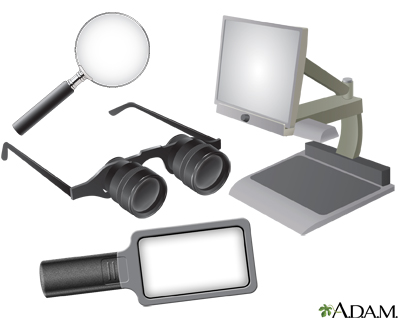Blindness and vision loss
Loss of vision; No light perception (NLP); Low vision; Vision loss and blindness
Blindness is a lack of vision. It may also refer to a loss of vision that cannot be corrected with glasses or contact lenses.
- Partial blindness means you have very limited vision.
- Complete blindness means you cannot see anything and do not see light. (Most people who use the term "blindness" mean complete blindness.)
People with vision that is worse than 20/200, even with glasses or contact lenses, are considered legally blind in most states in the United States.
Vision loss refers to the partial or complete loss of vision. This vision loss may happen suddenly or over a period of time.
Some types of vision loss never lead to complete blindness.

This x-ray shows the skull of a child with neurofibromatosis (NF-1). This child developed visual difficulties and was discovered to have a glioma (nerve tumor) in the optic nerve. The tumor has enlarged the bony opening (optic foramen), through which the optic nerve passes. This can be seen on the right side of picture.

People with partial vision loss can use low vision aids to help them continue to read and perform other tasks that use near vision. Low vision aids include magnifiers, binoculars, high power reading glasses, and electronic video magnifiers.
Causes
Vision loss has many causes. In the United States, the leading causes are:
- Accidents or injuries to the surface of the eye (chemical burns or sports injuries)
- Diabetes
- Glaucoma
- Macular degeneration
The type of partial vision loss may differ, depending on the cause:
- With cataracts, vision may be cloudy or fuzzy, and bright light may cause glare
- With diabetes, vision may be blurred, there may be shadows or missing areas of vision, and difficulty seeing at night
- With glaucoma, there may be tunnel vision and missing areas of vision
- With macular degeneration, the side vision is normal, but the central vision is slowly lost
Other causes of vision loss include:
- Blocked blood vessels to the retina
- Complications of premature birth (retrolental fibroplasia)
- Complications of eye surgery
- Lazy eye
- Optic neuritis
- Stroke
- Retinitis pigmentosa
- Tumors, such as retinoblastoma and optic nerve glioma
Total blindness (no light perception) is often due to:
- Severe trauma or injury
- Complete retinal detachment
- End-stage glaucoma
- End stage diabetic retinopathy
- Severe internal eye infection (endophthalmitis)
- Vascular occlusion (stroke in the eye)
Home Care
When you have low vision, you may have trouble driving, reading, or doing small tasks such as sewing or making crafts. You can make changes in your home and routines that help you stay safe and independent. Many services will provide you with the training and support you need to live independently, including the use of low vision aids.
When to Contact a Medical Professional
Sudden vision loss is always an emergency, even if you have not completely lost vision. You should never ignore vision loss, thinking it will get better.
Contact an ophthalmologist or go to the emergency room immediately. Most serious forms of vision loss are painless, and the absence of pain in no way diminishes the urgent need to get medical care. Many forms of vision loss only give you a short amount of time to be successfully treated.
What to Expect at Your Office Visit
Your health care provider will do a complete eye exam. The treatment will depend on the cause of the vision loss.
For long-term vision loss, see a low-vision specialist, who can help you learn to care for yourself and live a full life.
References
Cioffi GA, Liebmann JM. Diseases of the visual system. In: Goldman L, Cooney KA, eds. Goldman-Cecil Medicine. 27th ed. Philadelphia, PA: Elsevier; 2024:chap 391.
Colenbrander A, Fletcher DC. Vision rehabilitation. In: Kellerman RD, Rakel DP, Heidelbaugh JJ, Lee EM, eds. Conn's Current Therapy 2024. Philadelphia, PA: Elsevier; 2024:558-563.
Olitsky SE, Marsh JD. Disorders of vision. In: Kliegman RM, St. Geme JW, Blum NJ, et al, eds. Nelson Textbook of Pediatrics. 22nd ed. Philadelphia, PA: Elsevier; 2025:chap 661.
Raharja A, Whitefield L. Clinical approach to vision loss: a review for general physicians. Clin Med (Lond). 2022;22(2):95-99. PMID: 35304366
Version Info
Last reviewed on: 8/5/2024
Reviewed by: Franklin W. Lusby, MD, Ophthalmologist, Lusby Vision Institute, La Jolla, CA. Also reviewed by David C. Dugdale, MD, Medical Director, Brenda Conaway, Editorial Director, and the A.D.A.M. Editorial team.
